Embroidery is a distinctive art of embellishing the surface of a fabric material by employing a particular type of stitch. It also makes use of other accessories including pearls, sequins and beads to further enhance the grace of the material. India has been a centre of different types of embroidery crafts and its rich cultural history testifies this. As a matter of fact,Chikankari from Lucknow has a made a mark for itself amongst all other textile crafts of our nation. It has earned considerable recognition in the market due its extraordinary characteristics. Let’s delve into the noteworthy things about it and understand the real reason behind its reputation.
The literal meaning of the word Chikan is embroidery. It has been inferred from another word of Persian language i.e Chikeen which basically means flowered embroidery or intricate motifs on the fabric.
The adaptable nature of chikankari can be gauged from the variety of fabric upon which it is found. The different types of fabric include cotton, silk, chiffon and georgette. This diversity extends to the distinct kinds of clothing categories over which this embroidery is performed along with the variety of colors in which it is available in the market. Such versatile nature has accorded it a Geographical Indication Status in December 2008 which has validated its legitimacy in the domestic as well as the international market.
The Illustrious Past of this Embroidery
The past records about Chikankari indicate that it has always been a beloved embroidery of the affluent section of the society.
In the third century AD, a famous Greek traveller named Meghasthenese quoted about the presence of floral designs upon the Muslin clothes worn by the Indians in his account about the court of Chandragupta Maurya.
The historical evidence suggests that Chikankari was addressed as the court craft in 17th century by Nur Jahan during the reign of the mughal emperor-Jahangir. The inclination of the queen towards this embroidery made it eligible for the royal grant.
This craft earned a lot of accolades from the Nawabs of Awadh. They encouraged the craftsmen for their creative expertise. The Nawabs who were conducive in the growth of this craft are Nawab Asif-Ud-Daula (1775-1789) and Nawab Wajid Ali Shah (1851-1856). The masses beleived that the Chikankari outfits were one of the most treasured gifts in the royal families during that era.
The Nawab of Awadh- Shiraj-ud-daula considerably appreciated the beauty of Chikankari. He had a noticeable impact in the growth of this craft in the Awadh region.
This intensified the mass appeal of Chikankari within the commoners as well.
Consequentially, this craft was accorded the status of a social fabric of the state. The demand of this embroidery amplified to such an extent that it became a significant source of economic prosperity of the region. In this manner, the identity of Lucknow- the capital of awadh and Chikankari merged with each other.

The Making of Chikankari
The whole process of producing this embroidery involves a series of steps. The precision with which each step is executed leads to the superior quality of the final products.
The major steps involved in the entire process of manufacturing of Chikankari are as follows-
▪︎Selection of Fabric– The materials which are widely used for this embroidery are Chiffon, Silk, Georgette, Crepe, Cambric, Organza, Viscose, Cotton and Muslin.
▪︎Formulation of the blueprint of the design and sizing of the Material.
▪︎Preparing the outline of the Desired patterns using Block Printing technique– The motifs are engraved upon the wooden blocks. The blocks are used for different purposes including butis, floral designs and borders.They are immersed in dyes or neel and stamping of the desired patterns is done on the fabric afterwards. This process is called Chhapayi in the local community.
▪︎Conducting the actual procedure of embroidery using the multiple stitches-
After the completion of stamping of designs using the blocks , the needlework begins. The major raw materials which are used for undertaking the actual embroidery work are- needle, thread and frame.The fabric is protected using frames in order to conduct the process of embroidery in a hassle free manner.
▪︎Washing and Drying of the Material- The fabric is dipped in water in order to erase even the slightest trace of ink from the material. It is followed by an intensive washing and drying procedure. The fabric undergoes the process of starching prior to the ironing of the piece in order to make it robust enough for market use.
▪︎Providing the finishing touch with the application of Charakh (polishing and ironing of the fabric).
▪︎ Conducting the Quality Check to ensure the desired quality of the product.
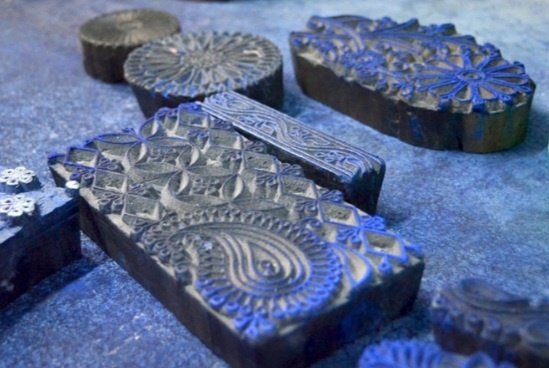
Stitches : The Fundamental Constituent of Chikankari
If anyone would ask you about one thing which nourishes this craft, just say- its none other than the stitches which are used within it. They nourish its beauty and hence become an integral part of this craft.
Although there are about forty stitches within Chikankari, let’s aware ourselves about the seven major types of stitches that are used in it.
•The most essential stitch in this embroidery is Tepchi. It can be identified through the parallel lines which are prepared using running stitch in right to left direction. Other patterns are developed over the fabric after this stitch. It serves as a defining characteristic of Chikankari.
•Another stitch which is termed as a substantial part of this craft is Zanzeera. It is also referred to as Chain Stich. This stitch is defined by a collection of interconnected loops that appear like a pattern of chain. It is basically used to create a layout of all the designs present within this embroidery. In this manner, it has an immense contribution towards the aesthetic appeal of this embroidery.
•The Shadow work (Bakhiya) is applied in this craft in order to create a delusion of depth across all the motifs. The exhaustive appearance of the designs over the upper side of the fabric is attained with the application of embroidery below the surface of the fabric.
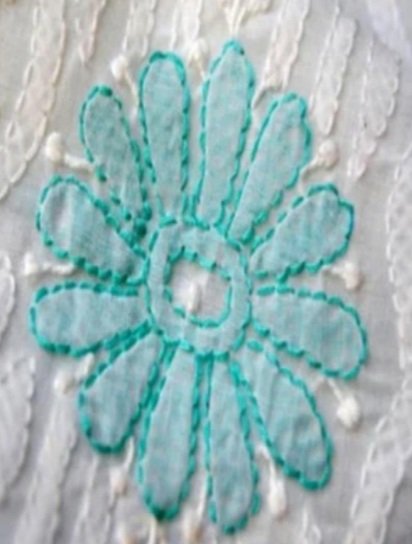
•The most commonly used stitch in this embroidery is Stem Stitch ( Keel Kangan ). It is a quintessential embroidery procedure which forms a rope like outline and serves as a well defined border of all the patterns prepared within this craft. The most unique feature of this stitch is the overlapping between the stitches which ultimately helps in getting the twisted effect over the fabric. In this manner, it plays an important role in making the motifs all the more intricate.
•The very presence of Knot Stitch (Phanda) represents the authenticity of any outfit embellished with Chikankari. The tiny knots above the fabric prepared with wrapping the thread around the needle a lot of times before passing it above the surface of the fabric helps it in forming diverse range of elegant shapes which add to the beauty of this craft.
•The French Knot (Murri Stitch) is an ornamental feature of this craft. This knot is carved out by circling the thread around the needle in continuity before putting it back into the fabric on a point which is closest to the area where it emerges initially. It can be distinguished with the smaller knots over the front side of the fabric which are quite helped in making the patterns all the more elaborate. This stitch makes this embroidery all the more interesting for all its spectators.
•The Hool (Eyelet Stitch) has a typical characteristic which gives a lace like look to the craft. The name of this stitch is derived from the shape of the miniature openings on the material which are in the form of an eyelet. The floral patterns which are commonly found in Chikankari appear all the more graceful with this stitch in their vicinity.
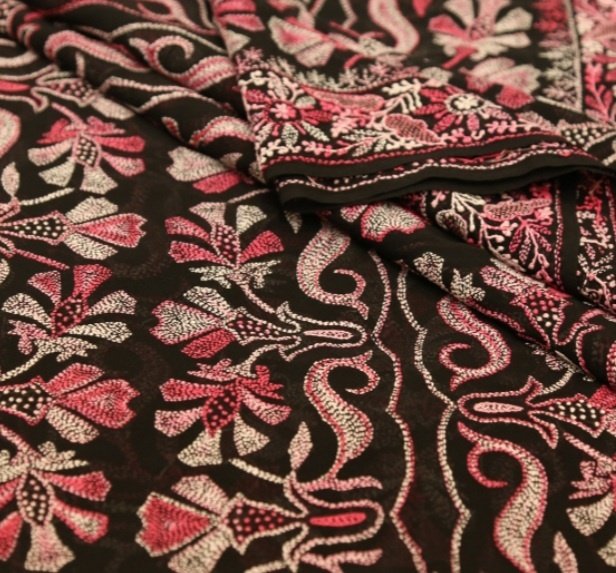
The Key Patterns in the Embroidery
Flowers have always been an eminent part of this embroidery. The craftsmen have kept them in the forefront with their aesthetic motifs.
The patterns of this embroidery majorly include the following flowers-
•Lilly
•Rose
•Jasmine
•Lotus
•Marigold
•Petunia
•Turanj
Apart from the floral motifs, the designs of Chikankari are derived from other natural elements also.
The major themes include the following-
•Rivers
•Mountains
•Crescent Moon
•Heart Shape
•Paisley or Kairi (Resembling the shape of a Mango)
•Peacock theme
•The tree of life or Kalpavriksha
•The Fish
•The Elephant
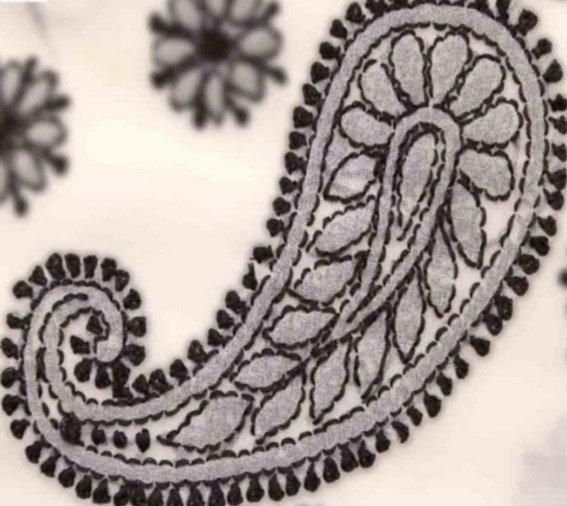
The Vivid Range of Colours
The colour which has been closely connected with this craft is white. It has also been referred as ‘white on white embroidery’ more often. The elaborate designs of the motifs become all the more attractive due to the monochromatic colour combination of the fabric.
The growing popularity of this handcrafted tradition has enhanced the range of colours which are used within it. Pastel shades of pink, purple and green colour of Chikankari are in vogue. The floral patterns used in chikankari become all the more nuanced due to these colours. This colour combination make the outfits quite exquisite which has enhanced its acceptance amongst its customers.
Although this craft has been synonymous with muted colour shades, a new trend has emerged these days which has led to the inclusion of radiant colour tones within it. The colours which are majorly preferred are darker shades of Red, Yellow, Pink and Blue.These shades are majorly preferred during celebrations and festivities due to the exuberance they bring in the immediate surrounding.
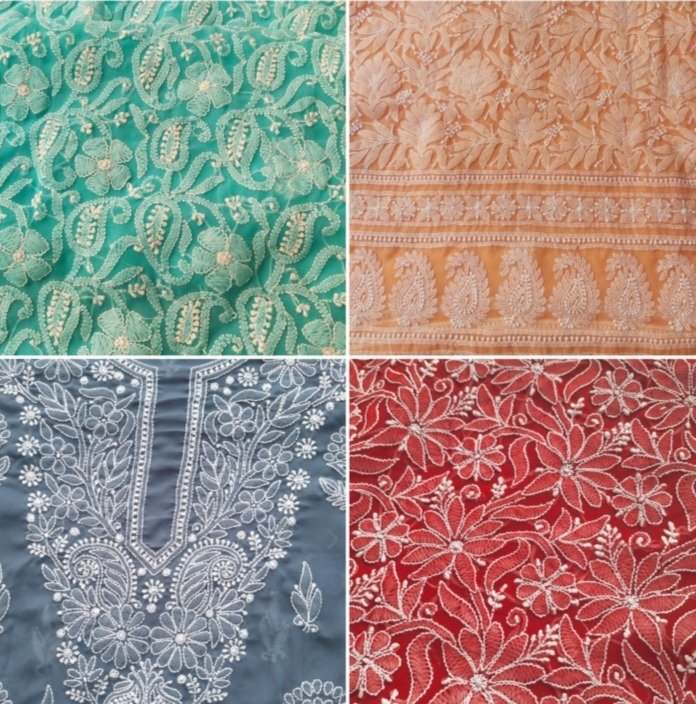
How has the Indian fashion industry embraced this craft?
The Indian Fashion industry has shown immense fondness towards Chikankari time and again. It has given enormous attention to its intricate yet aesthetic designs. Moreover, there are three fashion designers from India who have been committed towards the growth of this craft which has manifested in their work as well. Let’s take out some time and take a look into the extensive efforts undertaken by Abu Jani and Sandeep Khosla, Anjul Bhandari and Tarun Tahiliani for augmenting the progress of this textile craft from Lucknow.
Chikankari has carved out an exclusive position for itself as a major choice for bridal attire.
Abu Jani and Sandeep Khosla can be termed as the pioneers in this field as they have worked extensively on Chikankari from the initial phase of their career. They have always had a firm beleif over the timeless nature of this craft.A lot of variation is evident in their work due to the experimentative style they adopt in their collections. They enhance the visual aesthetics of their attires by combining this craft with zardozi, gotta patti and an elaborate border work.
They presented their first piece embellished with intricate motifs of Chikankari in the outfit of Shweta Bachhan for her wedding ritual in 1997. This laid the foundation for the usage of this craft within the wedding ceremonies of celebrities.
This trend was taken ahead by famous Bollywood actresses like Priyanka Chopra Jonas and Sonam Kapoor Ahuja who selected a Chikankari ensemble for their wedding outfit.
The Chikankari Saree which Deepika padukone opted for during her wedding reception at Mumbai in 2018 was an exceptional piece of art exclusively created by Abu Jani and Khosla.The demi saree was paired with a magnificent head dupatta.The combination of ivory and gold colour rendered an exquisite appearance to her outfit. Her attire was handcrafted and it was perfectly embellished with Swarovski Crystals and Gold Zardozi. The thoughtful beautification of the outfit gave it a touch of opulence.
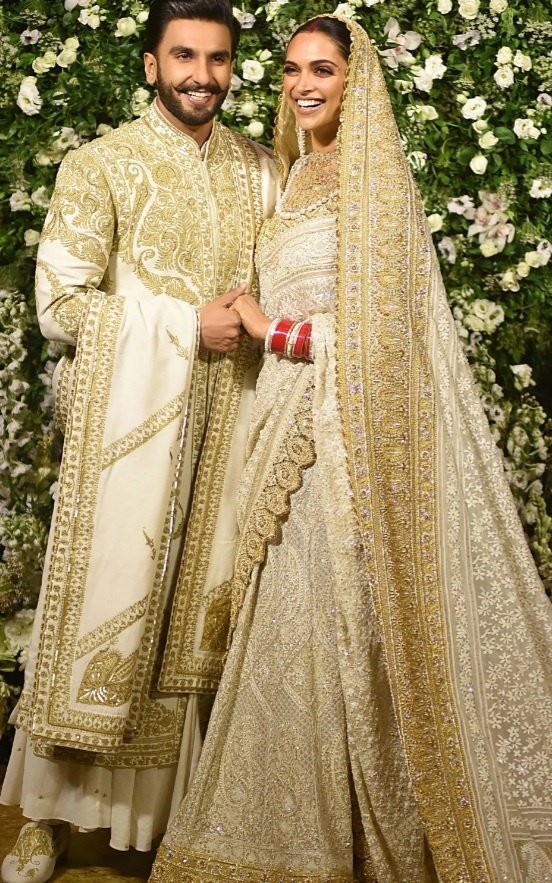
Sonam Kapoor was dressed in a multi paralleled Chikankari Lehenga during her wedding rituals in 2019. It was created with a Georgette fabric which was of a subtle colour pallete. Her outfit was quite rare due to the involvement of all the forty kinds of stitches in its preparation. Her radiant look was a result of the incessant efforts by Abu Jani and Sandeep Khosla.
The label which brought a revolution in the field of Chikankari was launched in 2010 by Anjul Bhandari. The reverence for this work on her part is depicted in her support for the highest number of Chikankari and Kamdani craftsmen of Awadh. Around 1500 craftsmen associated with her label belong to the fourth generation of the master craftsmen who had earned immense appreciation and patronage during the reign of last Nawab of Lucknow.Her admiration for this art reflects in her dedication towards the preservation of this handcrafted tradition.It gave this craft the recognition which it truely deserves. The fact which differentiates this label from others is its emphasis on hand stitched chikankari and the heritage value of this craft. This label does not compromise with the authenticity of this embroidery as it offers the unadulterated and purest form of Chikankari to its customers rather than the machine made ensembles.The brand’s strategy is to accept all the garments prepared with the rigorous efforts of the artisans by tackling their minor defects by adorning each piece with diverse ornamentation,silhouettes and styles.
Anjul Bhandari collaborated with Ensemble (A Multi-Designer Store) and unveiled a bespoke couture collection to commemorate the 35th anniversary of Ensemble in 2022. Gulah-e-Rang was launched to honour the journey of the renowned store. The name of this collection is derived from the distinct shades of colours present in a bouquet. The label adorned each attire with actual Swarovski crystals in order to impart a touch rarity to each outfit of Gulah-e-Rang. In addition to this, the label also reformulated the traditional approach towards Chikankari by altering the colour scheme of all the attires and infusing vibrant colours onto them in order to fascinate its prospective customers with the essence of the Spring season.

The wedding festive collection named Surkh Laal came up as a breakthrough in the field of Chikankari in 2022. The vibrant red colour which was an eminent part of this collection was inspired from the drying of a cluster of roses which are the usual sight at the historical city of Kannauj which is also referred as the Perfume capital of India.This reflected a reformist approach towards the craft as the label did not comply with the usual subtle and pastel hues which are deeply associated with this embroidery.

Ms. Anjul Bhandari included a variety of ethnic outfits including Lehengas, Salwars, Shararas and Sarees in this fifteen piece limited edition. This unique clothing edition portrayed the image of a twenty first century woman who exhibits a progressive personality which is fond of the customary traditions as well.
The two most charismatic pieces of Surkh laal were-
•The Mahee Saree– It was an extraordinary piece in the whole edition as it embodied the Awadhi tradition. The design of fish which defined this attire is considered a symbol of luck in Awadh. This motif was peculiar in various parts of the Saree including the border, jaal and pallu making it a part of the legacy of Chikankari.
•The Dagla– It was a variation of Angrakha Jacket which was an authentic piece of craft due to its remarkable silhouette. It was originally worn in the Royal families in the glorious past of Awadh.
The 2024 Naaz Collection by Anjul Bhandari complements with the Chand Maati collection of the label which illustrated the cosmic connection between the Earth and the Moon. It encapsulated the pious aura of the sky at night through the contemplated usage of embellishments like tiny sequins, lustrous pearls and the charming Swarovski ornamentations.
Naaz is an amazing combination of conventional artistry with modern silhouettes. The famous couturier has launched two colors together for the first time through this collection. Dusty Diamond and Soft Pink are two discrete hues presented in Naaz.
All the patterns of Naaz have been diligently planned to exhibit the elegance of Chikankari embroidery. The theme of the collection is focused upon providing a majestic impact to its customers. The common characteristics across the entire set of outfits of Naaz are as follows-
- Vintage Motifs
- Contemporary Silhouttes
- Elaborate Chikankari work
The gracious textile craft has also garnered immense appreciation from Tarun Tahiliani as well who emphasized upon its uniqueness by referring to it as the only Indian embroidery that fully blends with the textile without losing its drape. This craft is cherished by him so much that he denoted it as the lace of India.
This label came up with a variation in the manufacturing process of this embroidery in 2010. It replaced the blocks with its own artwork which made it quality more refined.
His love for Chikankari is can be easily discerned through his recent endeavors.
The bridal couture line of 2022 which was titled ‘The Painterly Dream‘ showcased a diverse variety of silhouettes across all the outfits which were thoroughly adorned with traditional Chikankari. The whole line included an ivory themed silk georgette fabric which was decorated with French knots, sequins, pearl hangings, Aari and Zardozi work. All the patterns were inspired from the inlay work on the surface of the tomb of I’timad-Ud-Daulah.
The wedding ensemble of Rakul Preet Singh of 2024 exemplified the artistic ingenuity of Tarun Tahiliani’s label. Her gorgeous ivory and gold hued Chikankari Lehenga was decorated with an alluring mirror work. It was matched up with a veil which was made out of silk tissue georgette. Her outfit showcased the enduring nature of the craft and emphasized upon its cultural significance across the nation as well.

An Interesting fusion with Popular Textile Crafts
In the contemporary world, the beauty of Chikankari is enriched further through its merger with the following-
•Mukaish– In this embroidery, metal wires are utilized to create detailed designs on the material. These metal wires are mainly of Gold and Silver color. It is primarily used on silk fabric. This craft is called Kamdani when tiny pieces of metals are used to embellish cotton fabric.
•Aari- Zari– Hooked needles are used for making comprehensive designs through Aari work. Silk and metallic threads along with beads and sequins are emoloyed to undertake Aari embroidery. Zari embroidery is carried out with the decorative metallic threads of Gold, Silver and Copper colour.
•Gotapatti– It is a Rajasthan based embroidery process in which applique work is used to come up with elegant patterns. It is defined with the use of bright colour shades and the application of metal embroidery over the surface of the fabric material.
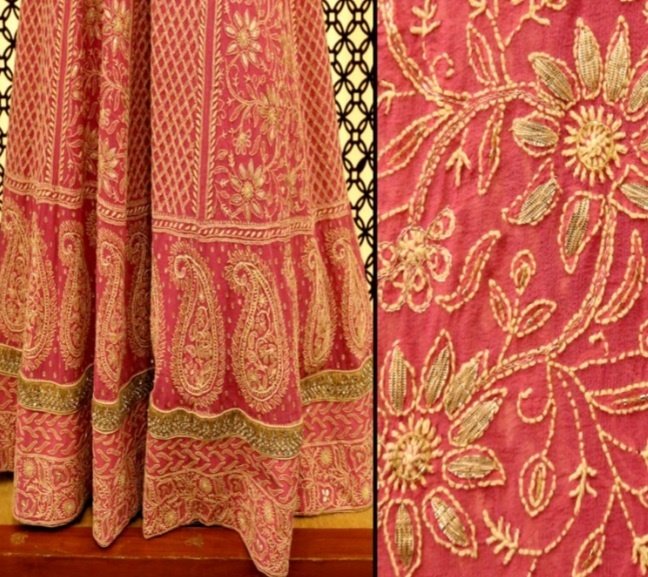
•Bead work– It is a special technique in which a string of beads are used for the ornamentation of the material.
•Mirror work– It is an ethnic embroidery procedure which involves attaching miniature pieces of mirrors over the fabric surface.
Hope you all have been acquainted with the heritage that a piece of Chikankari brings with itself. The above facts shall certainly influence your sentiments towards this embroidery when you shop for any outfit adorned with it. There’s just one appeal to each one of you i.e to contemplate regarding the amount of rigor that goes into the preparation of this fabulous craft while you buy it.



